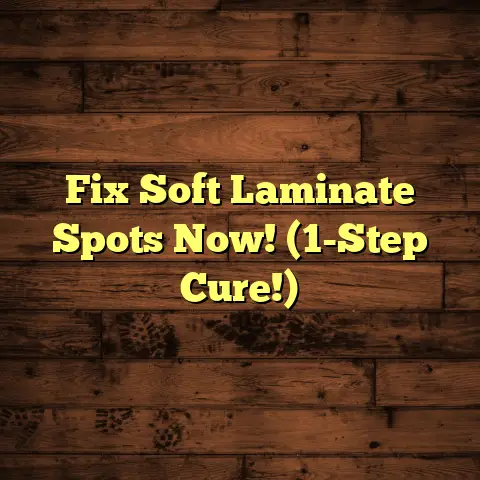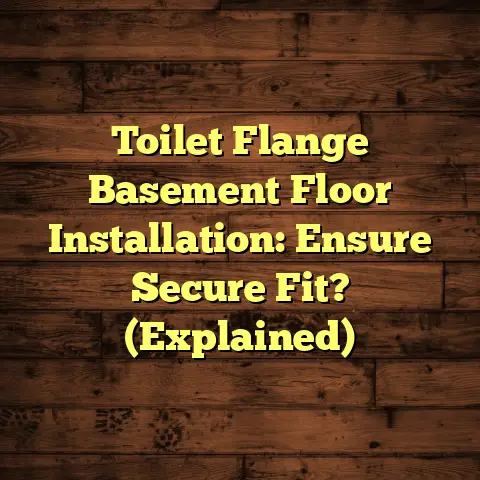Concrete Types For Floors? (4 Best Options!)
If you’re looking for a durable, stylish, and surprisingly quick flooring solution, concrete might just be your answer.
Forget those outdated images of cold, gray slabs.
Concrete flooring has evolved, and it’s
a fantastic option for homes, businesses, and
everything in between.
In this article, we’re diving into the four best types of concrete flooring that offer fast solutions for your needs.
Whether you’re a homeowner looking to upgrade your space, a contractor searching for efficient options, or a business owner needing a durable and attractive floor, I’ve got you covered.
We’ll explore polished concrete, stained concrete, concrete overlays, and self-leveling concrete, highlighting their benefits, installation processes, and unique applications.
Ready to get started? Let’s jump in!
Overview of Concrete as a Flooring Material
So, why concrete?
I get that question a lot.
Many people still think of concrete as something
cold and industrial.
But trust me, it’s so much more than that!
Concrete flooring offers a ton of advantages,
making it a top contender for any space.
First off, durability is where concrete shines.
I’ve seen concrete floors last for decades,
even in high-traffic areas.
Unlike carpet that wears down or hardwood that
scratches, concrete can withstand a serious beating.
Plus, it’s incredibly low maintenance.
A simple sweep and occasional mop are usually
all it takes to keep it looking great.
Think of the time you’ll save!
Another huge benefit is cost-effectiveness.
Compared to some other flooring options like
tile or hardwood, concrete can be significantly cheaper,
especially if you’re starting with an existing slab.
But here’s where it gets really interesting: customization.
Concrete is like a blank canvas.
You can
stain it, polish it, texture it, and even embed
decorative aggregates to create a truly unique look.
Want a floor that mimics the look of marble?
You can do that.
Prefer a rustic, earthy vibe?
No problem.
The possibilities are endless.
I’ve worked on projects where we’ve added everything from intricate patterns to company logos directly into the concrete.
And let’s not forget about versatility.
Concrete works beautifully in both residential
and commercial settings.
I’ve seen it used in everything from sleek, modern homes to bustling retail stores and industrial warehouses.
Its durability and aesthetic flexibility make it a perfect fit for just about any environment.
Now, for those of you who need a quick turnaround, concrete is surprisingly efficient.
With options like fast-curing sealers and overlays, you can transform a space in a matter of days, not weeks.
I’ve even done projects where we’ve completed the entire flooring installation over a weekend!
So, if you’re looking for a flooring solution that’s durable, customizable, cost-effective, and can be installed quickly, concrete is definitely worth considering.
In the following sections, we’ll dive into the four best types of concrete flooring to help you find the perfect fit for your needs.
Option 1 – Polished Concrete
Alright, let’s kick things off with one of my personal favorites: polished concrete.
This isn’t your grandpa’s dusty garage floor.
Polished concrete is a sleek, modern, and
incredibly durable flooring option that’s
gaining popularity for good reason.
So, what exactly is polished concrete?
Essentially, it’s concrete that has been
mechanically ground, honed, and polished to a
high-gloss finish.
The process involves using progressively finer grinding tools to smooth the surface and reveal the natural beauty of the concrete.
Think of it like sanding wood, but on a much larger scale.
I usually start with a coarse diamond grit and
gradually work my way up to a very fine grit
to achieve that mirror-like shine.
One of the biggest advantages of polished concrete is its reflective surface.
This not only enhances the lighting in a space but also makes it feel larger and more open.
I’ve seen it transform dark, cramped rooms into bright, inviting areas simply by reflecting natural and artificial light.
Plus, polished concrete is incredibly durable and resistant to stains and moisture.
This makes it ideal for high-traffic areas like retail stores, restaurants, and even residential living spaces.
I’ve installed polished concrete floors in busy coffee shops that have held up beautifully, despite constant foot traffic and spills.
In homes, it’s perfect for kitchens, bathrooms, and entryways where durability and easy cleaning are essential.
Now, let’s talk about installation.
While
polishing concrete can be a bit labor-intensive,
there are ways to expedite the process.
For example, using a concrete densifier can harden the surface and make it easier to polish.
I also recommend investing in high-quality grinding and polishing equipment to ensure a smooth, consistent finish.
And don’t forget about the finishing touches!
Adding a stain or dye before polishing can
create a unique and customized look.
I’ve used everything from subtle earth tones to bold, vibrant colors to achieve different aesthetic effects.
Also, consider adding a protective sealer to further enhance the stain resistance and durability of the floor.
I typically use a penetrating sealer that soaks into the concrete and creates a barrier against moisture and stains.
Polished concrete is a fantastic option if you’re looking for a durable, low-maintenance, and visually stunning flooring solution.
I’ve seen it elevate the look of countless spaces, and I’m confident it can do the same for yours.
Option 2 – Stained Concrete
Alright, let’s move on to another fantastic concrete flooring option: stained concrete.
This is where you can really get creative and add a ton of personality to your floors.
Stained concrete involves applying a stain to the concrete surface to change its color and enhance its natural variations.
Unlike paint, which sits on top of the concrete, stain penetrates the surface and creates a permanent bond.
This results in a more natural, mottled look that mimics the appearance of natural stone or other high-end materials.
There are two main types of concrete stains: acid-based and water-based.
Acid-based stains react chemically with the concrete, creating unique and unpredictable color variations.
I love using acid-based stains for their organic, earthy tones and their ability to add depth and character to the floor.
However, they can be a bit more challenging to work with due to their corrosive nature and strong odor.
Water-based stains, on the other hand, are more environmentally friendly and easier to apply.
They come in a wider range of colors and provide a more consistent and predictable finish.
I often use water-based stains when I want to achieve a specific color or create a more uniform look.
One of the biggest advantages of stained concrete is the quick turnaround time.
Unlike some other flooring options that require extensive preparation and installation, staining can be done relatively quickly.
I’ve completed staining projects in as little as a day or two, depending on the size of the space and the complexity of the design.
Plus, you can apply stains to existing concrete, making it a great option for a rapid transformation.
I’ve worked on projects where we’ve stained existing concrete floors in homes and businesses to give them a fresh, updated look without the need for a complete renovation.
Now, let’s talk about some real-world examples.
I recently completed a stained concrete project
for a local restaurant that wanted to create a
rustic, industrial vibe.
We used an acid-based stain to create a mottled, earthy look that perfectly complemented the restaurant’s decor.
The owner was thrilled with the results, and the customers loved the unique and inviting atmosphere.
I’ve also used stained concrete in residential settings to create everything from elegant, modern living rooms to cozy, rustic kitchens.
The possibilities are truly endless.
To keep your stained concrete looking its best,
it’s important to follow a few simple maintenance tips.
Regularly sweep or vacuum the floor to remove dirt and debris, and mop with a neutral pH cleaner.
Avoid using harsh chemicals or abrasive cleaners, as these can damage the stain and sealer.
Also, consider applying a fresh coat of sealer every few years to protect the stain and maintain its vibrancy.
Stained concrete is a fantastic option if you’re looking for a cost-effective, customizable, and relatively quick flooring solution.
I’ve seen it transform countless spaces, and I’m confident it can do the same for yours.
Option 3 – Concrete Overlays
Okay, let’s talk about concrete overlays.
If you’ve got an existing concrete floor that’s
looking a little rough around the edges, or if
you want to achieve a specific look without pouring
a brand-new slab, overlays might be the perfect solution.
Concrete overlays are thin layers of cement-based material that are applied over existing concrete surfaces to rejuvenate them or create a new decorative finish.
They’re like a facelift for your floors, and they can be installed much faster and cheaper than replacing the entire floor.
There are several different types of concrete overlays, each with its own unique properties and applications.
Micro-toppings are thin, smooth overlays that are used to create a seamless, polished look.
They’re perfect for covering up minor imperfections in the existing concrete and creating a smooth, even surface for staining or polishing.
Textured overlays, on the other hand, are designed to add texture and dimension to the floor.
They can be stamped with patterns to mimic the look of brick, stone, or tile, or they can be hand-troweled to create a unique, custom finish.
I’ve used textured overlays to create everything from rustic, cobblestone-style patios to sleek, modern entryways.
One of the biggest advantages of concrete overlays is the speed of installation.
Unlike pouring a new concrete slab, which can take days or even weeks to cure, overlays can typically be installed in a matter of hours.
This makes them an ideal solution for urgent flooring repairs or upgrades.
I’ve worked on projects where we’ve completely transformed a space in a single day using concrete overlays.
Plus, overlays can save you a ton of money compared to replacing the entire floor.
I’ve seen projects where overlays have saved clients thousands of dollars by avoiding the need for demolition and disposal of the existing concrete.
Now, let’s talk about some real-world examples.
I recently completed a project for a local business
that had a cracked and stained concrete floor in
their lobby.
Instead of replacing the entire floor, we applied a micro-topping overlay to cover up the imperfections and create a smooth, even surface.
We then stained the overlay to match the company’s branding and sealed it for durability.
The result was a beautiful, modern lobby floor that looked brand new, and the entire project was completed in just a few days.
I’ve also used concrete overlays in residential settings to create everything from updated kitchen floors to decorative patios.
The possibilities are truly endless.
To ensure a smooth application process, it’s
important to properly prepare the existing concrete surface.
This typically involves cleaning the surface, repairing any cracks or damage, and applying a bonding agent.
I always recommend using a high-quality bonding agent to ensure that the overlay adheres properly to the existing concrete.
Also, be sure to follow the manufacturer’s instructions carefully when mixing and applying the overlay.
Concrete overlays are a fantastic option if you’re looking for a quick, cost-effective, and versatile flooring solution.
I’ve seen them transform countless spaces, and I’m confident they can do the same for yours.
Option 4 – Self-Leveling Concrete
Last but not least, let’s talk about self-leveling concrete.
This is a game-changer when it comes to creating
a smooth, even surface for your flooring.
Self-leveling concrete is a cement-based mixture that is designed to flow easily and level itself when poured onto a surface.
It’s like magic in a bag!
You simply mix it
with water, pour it onto the floor, and it spreads
out to create a perfectly level surface.
This is especially useful when you have an uneven subfloor or want to prepare the surface for another flooring material, such as tile, carpet, or wood.
One of the biggest benefits of using self-leveling concrete is its fast curing time.
Unlike traditional concrete, which can take weeks to fully cure, self-leveling concrete typically cures in just a few days.
This means you can start installing your new flooring much sooner, saving you time and money.
I’ve worked on projects where we’ve poured self-leveling concrete on a Friday and were able to start installing the new flooring by Monday.
Self-leveling concrete is also incredibly versatile.
It can be used in both residential and commercial
settings, and it’s compatible with a wide range
of flooring materials.
I’ve used it to prepare floors for everything from ceramic tile to hardwood to luxury vinyl plank.
It’s also a great option for correcting uneven
subfloors.
I’ve seen it transform bumpy, cracked
concrete slabs into smooth, level surfaces that
are ready for new flooring.
Now, let’s talk about the application process.
While self-leveling concrete is relatively easy
to use, there are a few key steps to follow to
ensure the best results.
First, you need to properly prepare the existing
surface.
This typically involves cleaning the
surface, repairing any cracks or damage, and applying a primer.
I always recommend using a high-quality primer to ensure that the self-leveling concrete adheres properly to the existing surface.
Next, you need to mix the self-leveling concrete according to the manufacturer’s instructions.
It’s important to use the correct amount of water to achieve the proper consistency.
Too much water can weaken the concrete, while too little water can make it difficult to pour and level.
Once the concrete is mixed, you simply pour it onto the floor and spread it out using a gauge rake or trowel.
The concrete will then flow and level itself, filling in any low spots and creating a smooth, even surface.
Finally, you need to allow the concrete to cure completely before installing your new flooring.
This typically takes a few days, but it’s important to follow the manufacturer’s instructions to ensure the best results.
Self-leveling concrete is a fantastic option if you’re looking to create a smooth, even surface for your flooring quickly and easily.
I’ve seen it save countless hours on flooring renovations, and I’m confident it can do the same for you.
Conclusion
So, there you have it – the four best types of concrete for floors that offer fast solutions for your flooring needs.
We’ve explored polished concrete, with its sleek and durable finish; stained concrete, for adding personality and color; concrete overlays, for rejuvenating existing surfaces; and self-leveling concrete, for creating a smooth, even base.
Each of these options offers unique benefits and can be tailored to suit your specific needs and preferences.
Whether you’re looking to upgrade your home, renovate a commercial space, or simply find a durable and cost-effective flooring solution, concrete is definitely worth considering.
Remember, concrete flooring is not just about functionality; it’s also about aesthetics.
With the right techniques and finishes, you can create a stunning and unique floor that will enhance the look and feel of any space.
I encourage you to explore these concrete types further and consult with professionals to make informed decisions for your flooring projects.
Don’t be afraid to get creative and experiment with different colors, textures, and finishes to achieve the look you’ve always dreamed of.
And if you’re looking for a truly fast solution, consider options like concrete overlays or self-leveling concrete, which can be installed quickly and easily.
So, what are you waiting for?
It’s time to
take action and transform your floors with the
versatility and durability of concrete.
Good luck with your flooring projects, and I can’t wait to see the amazing spaces you create!





